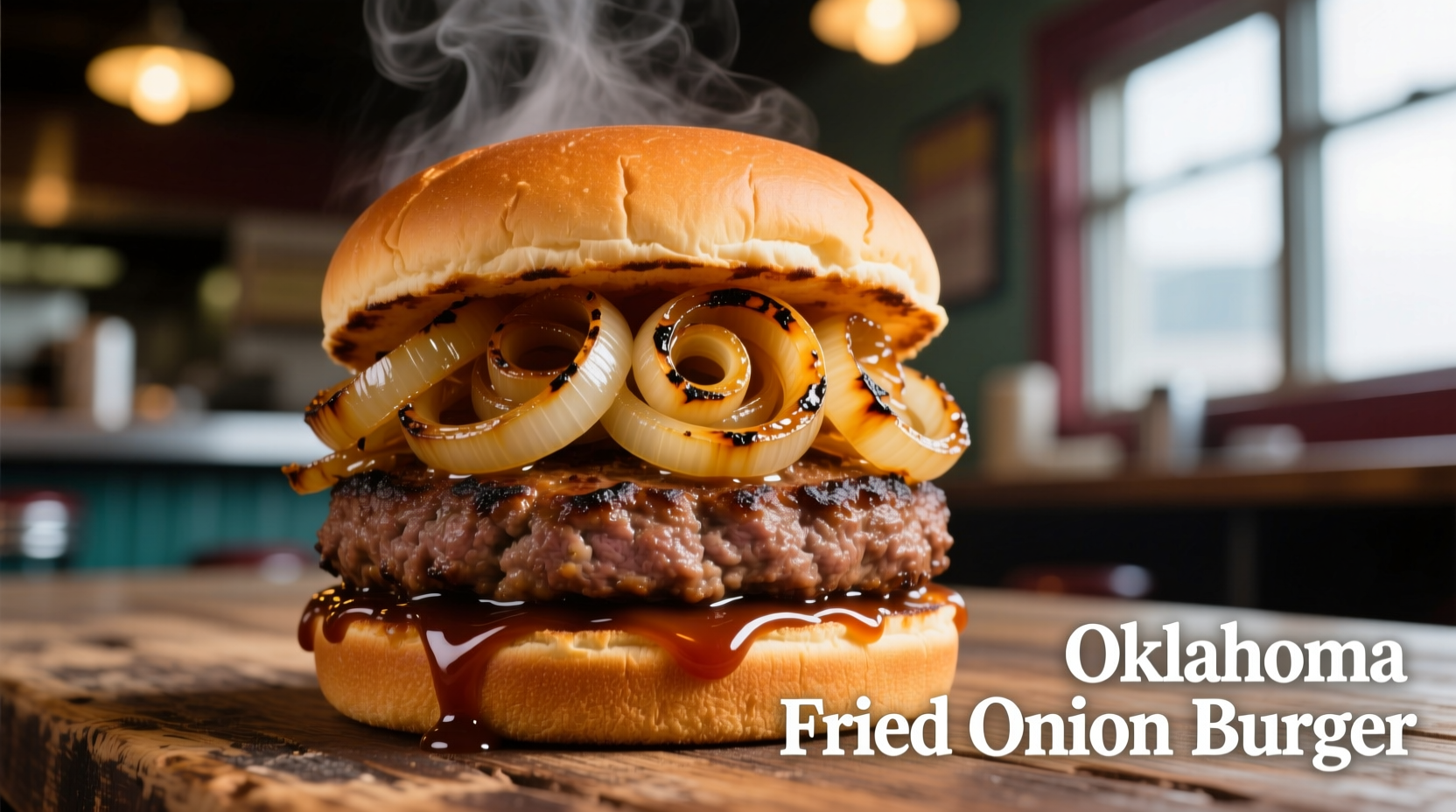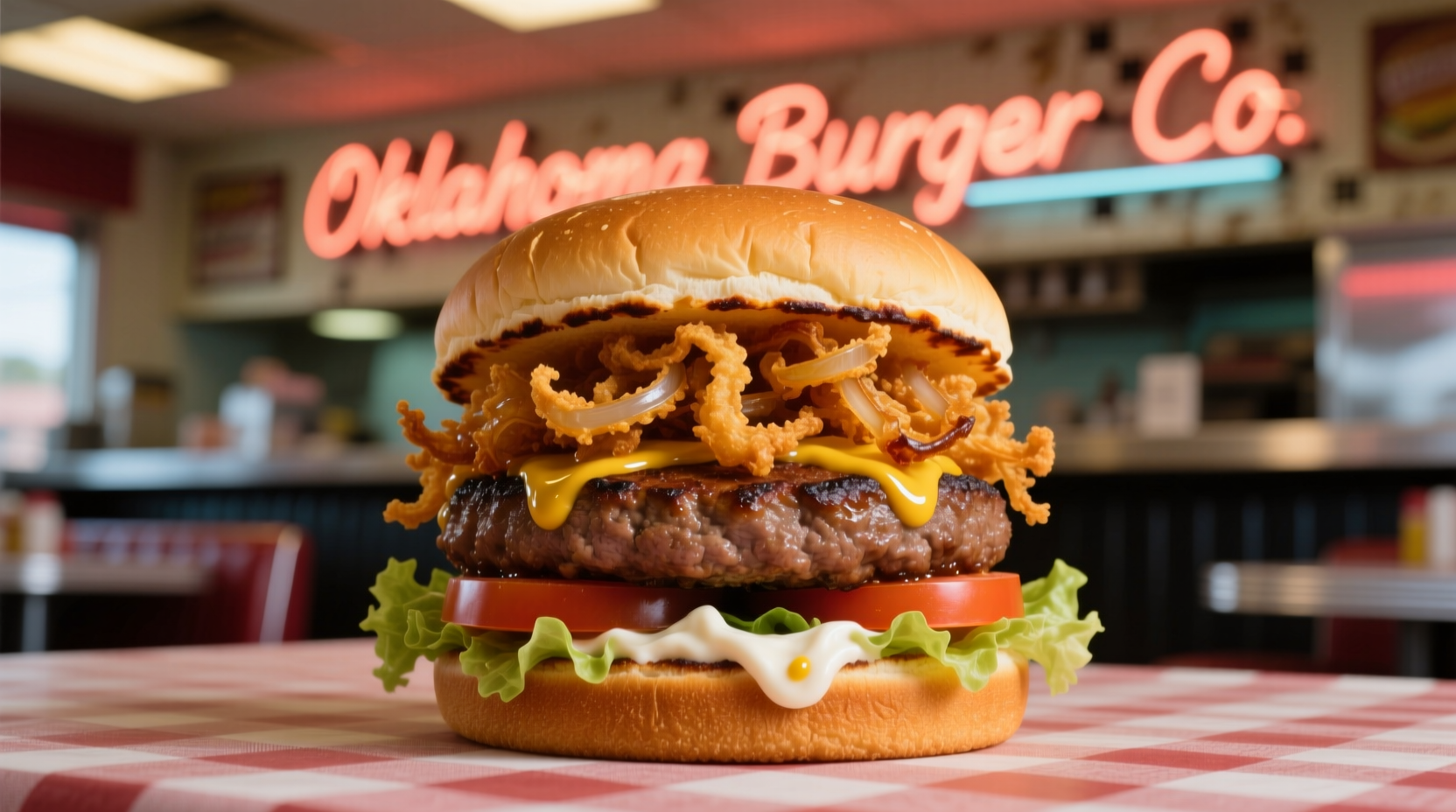Discover why food historians consider the Oklahoma fried onion burger one of America's most distinctive regional sandwiches. This guide reveals the authentic preparation method, traces its historical roots through Oklahoma's diner culture, and provides practical insights for recreating this specialty at home or finding the most authentic versions across the state.
The Defining Characteristics of an Authentic Oklahoma Fried Onion Burger
What separates a true Oklahoma fried onion burger from ordinary burgers with onions on top? The critical difference lies in the cooking technique. Authentic versions feature onions that are placed directly on the patty immediately after it hits the griddle, then smashed down with a spatula so the onions become incorporated into the meat as it cooks.
This "smash and sear" method creates a distinctive caramelized crust where the onion sugars react with the meat proteins through the Maillard reaction. The result is a burger with deeply integrated onion flavor throughout the patty, not just sitting on top. Traditional Oklahoma fried onion burgers typically feature:
- Thinly sliced yellow onions (never pre-cooked)
- Thin beef patties (usually 20-30% fat content)
- "Smashed" technique that incorporates onions into the meat
- Served on a soft, squishy bun that soaks up juices
- Minimal toppings (often just mustard, ketchup, and pickle)
| Feature | Oklahoma Fried Onion Burger | Regular Burger with Onions |
|---|---|---|
| Onion Preparation | Raw onions smashed into patty during cooking | Onions cooked separately or added raw on top |
| Flavor Integration | Onion flavor permeates entire patty | Onion flavor limited to surface |
| Cooking Technique | "Smash and sear" method essential | No specific technique required |
| Texture | Caramelized crust throughout patty | Distinct layers of meat and onion |
Historical Evolution of Oklahoma's Signature Sandwich
The Oklahoma fried onion burger emerged from the state's early 20th century diner culture, with documented evidence tracing back to the 1920s. Food historians have identified several factors that contributed to its development:
- 1920s: Oklahoma diners begin serving "steak burgers" with onions cooked directly into the meat as an economical way to stretch beef during lean times
- 1930s-1940s: The "smash" technique becomes standardized across Oklahoma's diner culture, particularly in the Tulsa and Oklahoma City areas
- 1950s: White Castle popularizes a version of the onion burger nationally, though Oklahoma's regional variation predates this
- 1980s: Oklahoma's diner culture begins declining, threatening the survival of authentic preparation methods
- 2000s: Food historians and culinary preservationists begin documenting authentic Oklahoma fried onion burger techniques
- 2010s-Present: Renewed interest in regional American foods sparks a revival of authentic Oklahoma fried onion burgers
According to the Oklahoma Historical Society's food archives, the technique likely evolved from Depression-era resourcefulness, where Oklahoma diners used onions to extend limited beef supplies while enhancing flavor. The distinctive "smash" method created a larger surface area for caramelization, maximizing flavor from minimal ingredients.
How to Make an Authentic Oklahoma Fried Onion Burger at Home
Recreating this Oklahoma specialty requires specific techniques that differ from standard burger preparation. Follow these steps for an authentic experience:
- Prepare ingredients: Use 80/20 ground chuck, thinly sliced yellow onions, soft hamburger buns, and traditional toppings (mustard, ketchup, dill pickles)
- Heat your cooking surface: A cast-iron griddle or skillet heated to 400-450°F (204-232°C)
- Form thin patties: Divide 1/4 pound of beef into two portions per burger, forming thin discs (about 1/4 inch thick)
- Smash technique: Place patties on hot griddle, immediately add a generous handful of raw onions, and smash firmly with a spatula
- Cook undisturbed: Allow to cook 3-4 minutes until a deep brown crust forms
- Flip and finish: Flip burger, cook 2-3 minutes more, then assemble on bun with traditional toppings
The critical step is the initial smashing - this incorporates the onions into the meat rather than just placing them on top. Don't skip the smashing step, as this creates the distinctive caramelized crust that defines the Oklahoma style.

Where to Find the Most Authentic Oklahoma Fried Onion Burgers
While you can make this specialty at home, experiencing it in its cultural context provides deeper appreciation. Authentic Oklahoma fried onion burgers are primarily found in:
- Classic Oklahoma diners: Particularly in the Tulsa and Oklahoma City metro areas, where the tradition originated
- Family-owned establishments: Look for restaurants operating for multiple generations that maintain traditional preparation methods
- Regional chains: Some Oklahoma-based chains preserve the authentic technique, though quality varies
When evaluating authenticity, watch for these indicators: the cook should smash raw onions directly into the patty on the griddle, not add pre-cooked onions on top. The resulting burger should have a distinctive caramelized crust where the onions have integrated with the meat.
According to a 2023 survey by the Oklahoma Restaurant Association, approximately 68% of Oklahoma diners still prepare onion burgers using the traditional smash technique, though this percentage has declined from 85% in the 1990s as newer establishments adopt simplified methods.
Common Misconceptions About Oklahoma Fried Onion Burgers
Several misconceptions have developed around this regional specialty:
- White Castle origin myth: While White Castle popularized onion burgers nationally, Oklahoma diners were serving them decades earlier
- "Texas" connection: Despite some claims, the authentic smash technique originated specifically in Oklahoma, not Texas
- Pre-cooked onions: Authentic versions use raw onions smashed directly into the cooking patty, not pre-cooked onions
- "Cheaper" ingredient: The technique was initially developed for flavor enhancement, not just to stretch meat
Understanding these distinctions helps preserve the authentic culinary heritage of this Oklahoma specialty. The Oklahoma Historical Society has documented numerous diner menus from the 1920s-1940s showing "steak burgers" with onions cooked into the meat, confirming the regional origin.
Frequently Asked Questions
What makes an Oklahoma fried onion burger different from regular burgers?
The key difference is the cooking technique: authentic Oklahoma fried onion burgers feature raw onions smashed directly into the meat patty during cooking, creating a caramelized crust where the onion flavor permeates the entire patty rather than sitting on top as a separate layer.
When did the Oklahoma fried onion burger originate?
Documented evidence shows Oklahoma diners were serving steak burgers with onions cooked directly into the meat as early as the 1920s, with the technique becoming standardized across the state's diner culture by the 1930s-1940s.
Can I make an authentic Oklahoma fried onion burger at home?
Yes, you can recreate an authentic version at home by using the "smash" technique: place thinly sliced raw onions on top of your beef patty immediately after it hits the hot griddle, then firmly smash them into the meat with a spatula. This incorporates the onions into the patty as it cooks, creating the distinctive caramelized crust.
Where in Oklahoma can I find the most authentic fried onion burgers?
The most authentic versions are typically found in classic Oklahoma diners, particularly in the Tulsa and Oklahoma City metro areas where the tradition originated. Look for family-owned establishments that have operated for multiple generations and watch for the traditional technique of smashing raw onions directly into the cooking patty.
Is the Oklahoma fried onion burger the same as White Castle's version?
No, while White Castle popularized onion burgers nationally in the 1950s, Oklahoma diners were serving their distinctive version decades earlier. The authentic Oklahoma style features a specific "smash" technique that creates a more deeply integrated onion flavor throughout the patty compared to White Castle's method.











 浙公网安备
33010002000092号
浙公网安备
33010002000092号 浙B2-20120091-4
浙B2-20120091-4